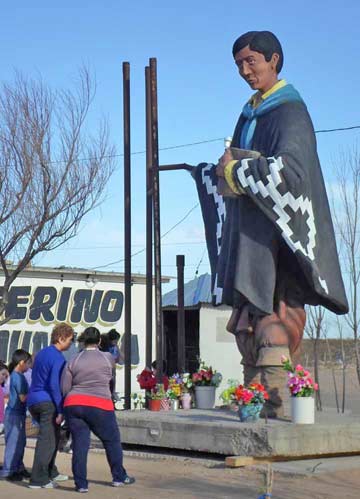| There's History in every Story |
|

In semi-desert country, west of the city of Neuquén, in Argentine Patagonia, the scenery is interrupted by a cluster of small buildings at the roadside. A realistic, giant statue fixes the driver’s attention, begging one to stop and look. We stopped.
The figure is of a young man, wearing a traditional quillango (poncho) and carrying a book in his left hand — the Bible. His name — Ceferino Namuncurá. His claim to fame — beatification by the Church of Rome.
Paraphrasing the comic-strip character Condorito, “this calls for an explanation”. To be frank, I have more questions than answers, but they must suffice for now.
Ceferino Namuncurá (1886-1905, henceforth CN) was the son of a once-powerful mapuche chieftain, who had been forced to capitulate before the modern armaments of the Argentine Republic. CN was educated by Salesian priests, first in Buenos Aires (where he came recommended by a former Argentine president) and then in Viedma. His desire to join the priesthood was frustrated by tuberculosis, which he had contracted as a youth. In 1904, seeking medical care, he was sent to Turin, headquarters of the Salesian order, and was subsequently presented to the Pope. CN died in Rome the following year. His remains were repatriated in 1924 by the Argentine government.
Question #1: Why was CN given privileged treatment in Argentina? Pedigree and personality do not appear to be sufficient explanations. Was he a convenient figure of national expiation, after the violent suppression of Patagonian native resistance in the “Campaign of the Desert”?

Question #2: Why did the Italian church hierarchy pay so much attention to CN? Did they see him as a future agent of evangelisation among his own people? Conversely, could he have been merely a figure of curiosity, the intelligent son of an infidel, in the tradition of the three Fuegians presented by Captain Robert FitzRoy to British royalty in 1831?
Question #3: What factors assisted CN in his path to beatification? Was it youth, or docility, or a well-intentioned desire to assist “his people”? It is noteworthy that his child’s face (the “little Indian”) appeared on devotional cards and medallions, just like those of the saints and martyrs. He did not die for his cause, but he did die with an unfulfilled aspiration. The message would have been simple, wholesome, and marketable.
Question #4: Why has CN become a popular cult figure? Does he represent the suffering and discrimination experienced by native people? Is his steadfastness to the church in the face of an implacable disease perceived as self-sacrifice? There may be parallels here with other local cult figures:Difunta Correa, who died from thirst and starvation rather than be disloyal to her husband; and Laura Vicuña (1891-1904), who offered up her own life to expunge her mother’s immorality.
Coincidentally or not, part of Laura’s story also took place in Neuquén, and her beatification was also promoted by the Salesians. This religious order is known in Patagonia for its emphasis on education: may they also have taken this opportunity to apply some more traditional persuasion?
o - O - o